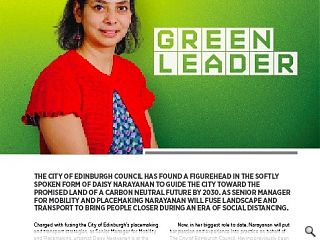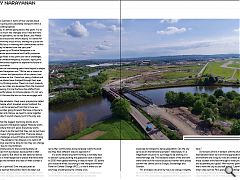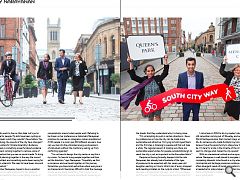Daisy Narayanan
22 Jul 2021
The City of Edinburgh Council has found a figurehead in the softly spoken form of Daisy Narayanan to guide the city toward the promised land of a carbon neutral future by 2030. As senior manager for mobility and placemaking Narayanan will fuse landscape and transport to bring people closer during an era of social distancing.
Charged with fusing the City of Edinburgh’s placemaking and transport strategies, as Senior Manager for Mobility and Placemaking, urbanist Daisy Narayanan is at the forefront of efforts to meet the city’s ambitious carbon neutrality targets by 2030, and ensuring that the capital emerges from the pandemic as a greener and a healthier place. With a lifetime’s passion for architecture and urban design, Narayanan is also experienced, having worked across the UK and Asia. She first arrived in Britain in 2004 as a student, quickly establishing herself as a potent force for change through high-profile stints as director of urbanism at Sustrans, as well as serving the Edinburgh Climate Commission and the Climate Assembly Evidence Group.
Now, in her biggest role to date, Narayanan will put her passion and experience into practice on behalf of The City of Edinburgh Council. Having previously been seconded to the authority in 2018 and 2019 to lead Edinburgh’s ten-year city centre transformation plan, when she championed the introduction of a monthly car-free event in the Old Town, Narayanan is acutely aware of the responsibility she bears to all residents from the city centre World Heritage sites to the furthest flung residents in Sighthill. Her initiatives such as the City Mobility Plan for introducing carbon-neutral transport options and the 20-minute neighbourhood programme have helped to further her aims. Speaking to Urban Realm following her appointment Narayanan said: “I brought a lot of my learning from Edinburgh to Sustrans in terms of how we talk about walking and cycling and sustainable transport within a wider city-building agenda. In a sense, it’s almost going back a few years. It’s so familiar but so much has changed since I was last here. We’ve had the pandemic; we’ve had Black Lives Matter and we’ve had discussions around equity. In a sense for me that is where my focus will be, looking not just at the city centre. My focus is working with communities to find out what they’ve learned over the past year.”
Having grown up in Mumbai Narayanan is no stranger to acute environmental and traffic pressures but Edinburgh faces a very particular set of challenges, including the climate emergency, inclusion, equity and bringing communities together to explore the future of their neighbourhoods. Asked how the intervening years have helped to shape her world view Narayanan said: “We’ve had a chance to reassess our values and perceptions of our places, how we live and where we live. I have two young children and watching how places have changed through their eyes has helped my thinking evolve. There’s so much inequity built into how our cities are developed from the transport system to housing.
For me the focus has shifted from creating beautiful places to inclusive places, it’s not very different but it focuses the lens on how we engage with people. “Before the pandemic, there was a programme called Spaces for People which travelled across Scotland. For me, there is a lot to be learned from that in how we shape communities going forward. We have a chance to come together and change, we need to come together and collaborate. It sounds cheesy but it’s the only way forward.” Asked what the biggest stumbling blocks are to achieving these aims Narayanan replied “Nobody wants to live somewhere that isn’t good. Everybody wants spaces and cities to be the best that they can be but there are different ways of going about that. There are always going to be challenges around finance and solid thinking and pacing. The pandemic has allowed us to switch off from how things used to be done to how they can change very quickly due to circumstances. “It’s not always easy to discuss taking away car parking spaces from businesses because that’s what everybody is used to. But when we talk about evidence and say ‘here is what happened to places that have done this it changes the narrative and idea of what a street is meant to be.
“Transport is political. Over the past years at Sustrans, I’ve learned that politics has to be taken out of placemaking as far as possible to get city leaders and elected members to agree. Elected members are there to serve their communities and everybody wants the best but they have different ways to approach it.” In a world where long-term thinking is normally tied to election cycles pushing the goalposts back a decade to 2030 when global warming is likely to reach 1.5C above pre-industrial levels, according to the Intergovernmental Panel on Climate Change (IPCC), is vital if there is to be any hope of addressing the climate crisis. One factor in Edinburgh’s favour is its compactness which makes it well-positioned to act quickly and decisively to transport a dense population.
Can the city serve as an international exemplar? “Absolutely. It’s a magnificent city and it’s a privilege to be working in a world heritage site. The medieval streets of the old town were never built for tourist buses but neither were places outwith the centre such as Gorgie, Stockbridge and Granton. “It’s a timeless city and my role is to change it slightly for the better and then hand it on to the next generation. We’re so well positioned in geography and the places we have.”
As horizons shrink in tandem with the shutdown of international travel we’re all more appreciative of our local environment and living our lives at a slower pace. Can these societal shifts feed through to what you’re doing and accelerate your goals? With tourists gone, what’s it like to have the city to yourself at last! “Learning from other cities such as Paris everything is changing and we have the opportunity to shape some of that change”, says Narayanan. “So let’s make sure we have options for people who want to hop on their bike. Let’s put in infrastructure for people. My kids have been cycling on city-centre streets which they wouldn’t have before. You can hear birdsong, the sounds of the city have changed.”
“I sit on Scotland’s Climate Assembly’s Evidence Group and there is something powerful about evidence and engagement coming together to remove some of the misinformation that you see on social media. To bring transport and planning together in the way the council has done is brilliant and something we’ve been saying for a long time as urbanists. We need to have fewer silos and more collaboration.” By November Narayanan hopes to be in a position to reveal some concrete ambitions for her adopted city but in the meantime, she is undertaking a series of conversations around what people want. Refusing to be drawn on her preferences a diplomatic Narayanan promises to oversee as collegiate a role as possible but if 100 people in a room give 100 different answers, how can you tap into the embodied energy and passions of individuals without the machinery seizing up from conflicting agendas? “I’m not here to design the city centre or say this is my vision. I’m here to bring people together and then set the direction,” says Narayanan.
“Hopefully we find a consensus and we travel together on this journey. Sometimes you have local authorities where everyone is so stressed and it becomes difficult to hold the message of why we are doing something. That is why it is so important that when people see bollards appearing on the streets that they understand why it is being done. “It’s so tempting to push in certain directions. I have my preferences on how the city can be made more sustainable and attractive. I’m trying to hold myself back and the first step is listening to people and that will take a while. The regional aspect of making sure there are sustainable opportunities for people outside Edinburgh to reach the city is just as important as the fine urban fabric.”
Despite not having formally stepped into the role Narayanan has already had a foretaste of the type of pressures to be expected with her seven-year-old daughter wasting no time to inform her of every dropped kerb needing installed on the cycle to school. “Whenever she sees a dropped kerb she says, ‘mum can you please sort this out?’ I’ll be the one everyone wants to shout at!” I came here in 2004 to do my master’s degree and I still remember coming out of Waverley and seeing the World Heritage skyline, that moment stays with you for life. As someone who made Scotland my home, I can’t believe I have the opportunity to shape how the city will be. I’m here for a blip in the timeline of the city and I don’t want to change what makes the city special.” With an international outlook and an approachable nature, Narayanan is well placed to navigate the competing interests to be found in a city where commercial and heritage pressures combine with the often-divergent needs of locals and visitors to present a headache for policymakers. At a pivotal moment in history, Edinburgh’s mobility and placemaking strategy are in good hands.
|
|





